- Pecan Nitrogen Use & Clover Compatibility
- Soil Building & Sustainability
- Pest Management Enhancement
- Selecting a Clover Variety for the Orchard Floor
- Establishment & Maintenance
- Costs & Savings
- Estimating the Nitrogen Benefit of Clover
- Summary
- References
An orchard floor provides a working surface for orchard operations and influences activities in the trees, which produce the crop. An efficient orchard floor cover does not compete heavily with trees for moisture and nutrients and is compatible with orchard insect populations. While weed competition with tree roots is significant throughout the life of the tree, in a newly planted orchard, weed competition can significantly reduce young tree survival and can stunt tree growth. Weed competition can reduce tree growth and yield, as well as promote alternate bearing in mature trees.
 Figure 1. A well-established stand of crimson clover growing in a well-managed pecan orchard.
Figure 1. A well-established stand of crimson clover growing in a well-managed pecan orchard.Pecan trees have an extensive root system, consisting of a tap root that can penetrate as deep as the soil structure and water table permit, and small feeder roots located near the soil surface. These feeder roots supply the bulk of the pecan tree's nutritional needs and come into direct competition with vegetation on the orchard floor.
Pecan orchard floors usually consist of sod culture with a weed-free herbicide strip approximately 12 to 15 ft wide along the tree row. Row middles are maintained by mowing, which improves wet weather passage for spraying, harvesting and other orchard operations. Cool season legumes, such as clover, posses a variety of characteristics that make them compatible with pecan production (Figure 1). Cool season legumes are not especially competitive with trees for soil moisture until mid- to late spring. They also serve as an effective source of organically bound nitrogen (N). In addition, cool season legumes stimulate an early increase in beneficial insect populations. The environmental benefits of cool season legumes make their use in pecan orchards an especially attractive practice. In addition to the benefits mentioned above, legumes can also reduce weed competition, aid in the cycling of nutrients, build soil organic matter, and prevent soil erosion and runoff.
Pecan Nitrogen Use & Clover Compatibility
Of all nutrients applied to pecans, nitrogen (N) most commonly limits pecan growth and orchard profitability. This element has a dominant influence on vegetative growth and crop production. With regard to pecan production, leguminous plants, particularly crimson and white clovers, planted on the orchard floor can provide an efficient source of N.
 Figure 2. Legume nodules.
Figure 2. Legume nodules.All legumes, including clover, utilize soil-dwelling bacteria that convert nitrogen from the air into a form that can be used by plants. This process is called "nitrogen fixation." Only particular strains of bacteria provide optimum N production for each group of legumes. When the roots of a leguminous plant come into contact with the appropriate bacteria, the root hairs encircle the bacteria to create a nodule (Figure 2) that houses the bacteria. These lumps on the root surface may range from the size of a BB to a kernel of corn.
Perennial legumes "fix" N during any time of active growth, usually peaking at flowering. With seed formation, N fixation ceases and the nodules slough from the roots. While they are alive, legumes release little to no nitrogen. As they die and are decomposed by soil microorganisms, the N in the roots, stalks, leaves and seeds is converted to a form available to other plants. Residue from a grass/legume mix has a higher C:N ratio than the legume alone, thus the release of N is slow and not as vulnerable to loss.
Nitrogen uptake in the pecan tree is driven by demand, and mature pecan trees require 75-150 lb of N annually for optimum production. There are two critical periods of nitrogen demand during the season: (1) early foliage growth and (2) kernel filling. The early spring foliage flush is nourished primarily from reserves held within the tree, while the nitrogen demand during the kernel fill stage is usually satisfied from soil uptake. If N is limited at kernel filling, then the tree will mobilize N from the foliage to the kernels.
A vigorous stand of crimson clover will contribute between 70 and 150 lb of N per acre, an adequate but not excessive amount for pecans. A vigorous stand of white clover can fix 100-150 lb of N per year depending on soil and growing conditions. When aided by moisture and warm weather to speed up decomposition, up to half the N available from legumes can be released within 7 to 8 weeks. For best results, a combination of white and crimson clover is recommended.
Pecans are an "irregular bearing" crop, meaning that they tend to bear heavy crop loads for one to two years, followed by very light crop loads, depending upon various physiological and environmental factors. In the light crop or "off" years, the N supplied by the clover alone would be adequate for optimum production. Heavy crop or "on" years may require additional N to bring marketable nuts to maturity and provide for a return crop the following year.
Previous research indicates a time lag between legume establishment and the response of the pecan tree. In most cases, annual applications of N will be needed for two to three years following legume establishment.
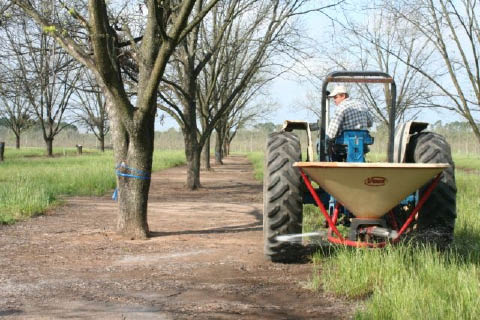 Figure 3. Broadcast band application of fertilizer into the herbicide strip of a pecan orchard.
Figure 3. Broadcast band application of fertilizer into the herbicide strip of a pecan orchard.It is important to recognize that the ability of the legume plant to "fix" nitrogen is destroyed by the presence of readily available N in the soil. Little to no fixation occurs when available soil N is present, and legumes will use it in preference to atmospheric N. Fertilizing orchards utilizing legumes at the wrong time can also lead to aggressive growth of grasses and other competitive species, which can lead to shading out of the legume crop.
Therefore, N applications to orchards utilizing clover should be made via fertigation or as a broadcast band application, directed to the herbicide strip only (Figure 3). Supplemental N applied to row middles should only be applied to orchards utilizing legumes after N fixation by the legumes has ceased (after full bloom).
Soil Building & Sustainability
Legumes can improve orchard soils in a number of ways. Protection against erosion is the most obvious benefit, but the addition of organic matter is an equally important and more long-term goal. Clover can provide habitat and/or food source for important soil organisms, break up compacted soil layers and help dry out wet soils.
Erosion deprives orchards of topsoil, the most fertile portion of soil with the highest amount of organic matter. When soil particles are dislodged by rainfall, they are more vulnerable to runoff. Cool season legumes can reduce the impact of rainfall on bare ground, slow the action of moving water, increase the soil's ability to absorb and hold water, and help stabilize soil particles. Crimson clover produces more dry matter (5,600-6,000 lb per acre) than many other legumes and is recommended for soil erosion control because of its high early autumn dry matter production. Grass/clover mixtures combine fibrous surface roots with long tap roots and have been observed to reduce herbicide runoff by 94% to 100%.
Overfertilization is common in orchard crops because most growers rely on synthetic fertilizers. The amount of nitrogen removed by the crop in proportion to that applied is often far less with tree crops than with more traditional crops; therefore, nitrates leaching into groundwater can be serious in orchard situations.
Winter cover crops such as clover grow primarily during a period of tree dormancy, when N uptake by the crop is at a minimum and percolation from rainfall is often the greatest.
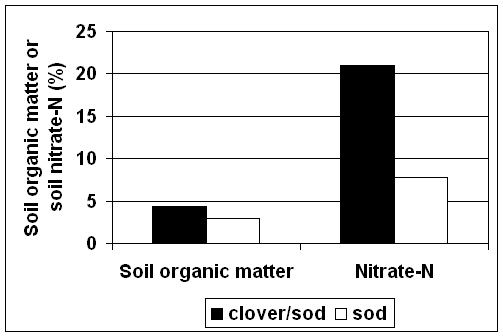 Figure 4. Soil organic matter and soil nitrate levels of pecan orchard soils utilizing clover/sod or sod as an orchard floor covering.
Figure 4. Soil organic matter and soil nitrate levels of pecan orchard soils utilizing clover/sod or sod as an orchard floor covering.Perennial legumes break down quickly; however, their root systems remain tough and fibrous, contributing to the accumulation of organic matter. While orchard soils typically retain relatively high levels of organic matter, pecan orchards utilizing clover have significantly higher soil organic matter and soil nitrate levels than those without clover (Figure 4). Adding organic matter to soils improves soil structure, increases water-holding capacity and provides more efficient nutrient storage by increasing cation exchange capacity (the ability of the soil to act as a short-term storage bank for positively charged plant nutrients).
Legumes help to increase the total number and diversity of soil organisms, which is the key to a healthy, well functioning soil. Legumes are also closely associated with beneficial fungi, called mycorrhizae, which produce a water-insoluble protein known as glomalin. This material binds and glues together particles of organic matter, plant cells, bacteria and other fungi. The resulting well-aggregated soils are less prone to compaction.
Pest Management Enhancement
Conserving and encouraging beneficial organisms is key to achieving sustainable pest management. Clover blossoms attract various bee species, which feed readily on the abundant nectar. In addition, blooms may harbor beneficial insects such as the minute pirate bug. Pea aphids and blue alfalfa aphids are commonly associated with crimson clover. Although these species are not pests of pecan, they serve as alternative food sources for beneficial predators such as lady beetles, green lacewings, soldier beetles, predaceous stink bugs, damsel bugs and hover flies. As the clover declines with the onset of warm weather in June, these beneficial insects move into the trees to feed on pecan aphids and other insect pests, reducing the need for insecticide application.
In addition to reducing insecticide inputs by enhancing beneficial insect populations, the use of legumes in the orchard can also reduce herbicide use. As clover grows, it forms a thick, living mulch that helps to smother and shade out more troublesome, competitive weed species. White clover has a creeping growth habit and spreads with rhizomes or "runners," which helps to fill voids in the orchard and is a very effective means of reducing weedy competition.
Selecting a Clover Variety for the Orchard Floor
Many commercial legume varieties are available on the market. Select a high-yielding, persistent and disease-resistant variety that is well suited to the growing environment. Many clover varieties are susceptible to viruses that decrease productivity and shorten stand life. More recently developed varieties produce good yields, have excellent tolerance to defoliation and survive for many years. Carefully consider orchard management practices before selecting a clover variety.
Large or ladino white clovers are later blooming and more upright in growth than the small or intermediate clover types. This may make them unattractive for pecan orchards because they make it difficult to move about. In addition, they are not dependable re-seeders and have fewer stolons and leaves close to the ground. Intermediate types reseed more dependably and posses many ground-level stolons, which helps to reduce weed competition.
Ball clover, which was introduced from Turkey, has small ovate leaflets and small white to yellowish-white flowers. Stems may grow up to 3 ft and are prostrate to partially erect, often forming a thick mat. This makes it valuable for weed suppression as well as a good N source. Seed are very small (approximately 1,000,000 per pound) with a recommended seeding rate of 3 pounds per acre. Ball clover does best on loam and clay soils but has done well on relatively level sandy soils near creek or river bottoms that maintain good soil moisture. It does not have good drought tolerance, and growth will be reduced in a hot, dry spring. It prefers a soil pH of 6.0 or higher. Ball clover cannot tolerate wet soils as well as other clover species.
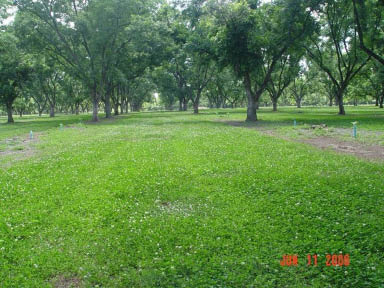 Figure 5. Durana clover.
Figure 5. Durana clover.Photo: Bill Goff, Auburn University.
Durana clover (Figure 5) is a white variety with small leaves and many stolons, which allows aggressive spreading and excellent traffic tolerance. It flowers profusely for long periods, making it a dependable re-seeder. During cultivar development, Durana was selected partially for its ability to survive hot, dry conditions. Clover normally requires adequate water, which makes it best suited to solid-set sprinkler irrigated orchards. Durana's drought tolerance makes it better suited to drip or microjet sprinkler irrigated orchards than other clover varieties. In addition, Durana remains green year-round and, if used in the orchard, can be easily harvested on when mowed prior to harvest. Because of its year-round growth, Durana may not be suited to orchards in which chem-mowing is utilized. Durana may be slow to establish during the first year, but it out-competes other clover varieties in subsequent years due to its vigorous stolons.
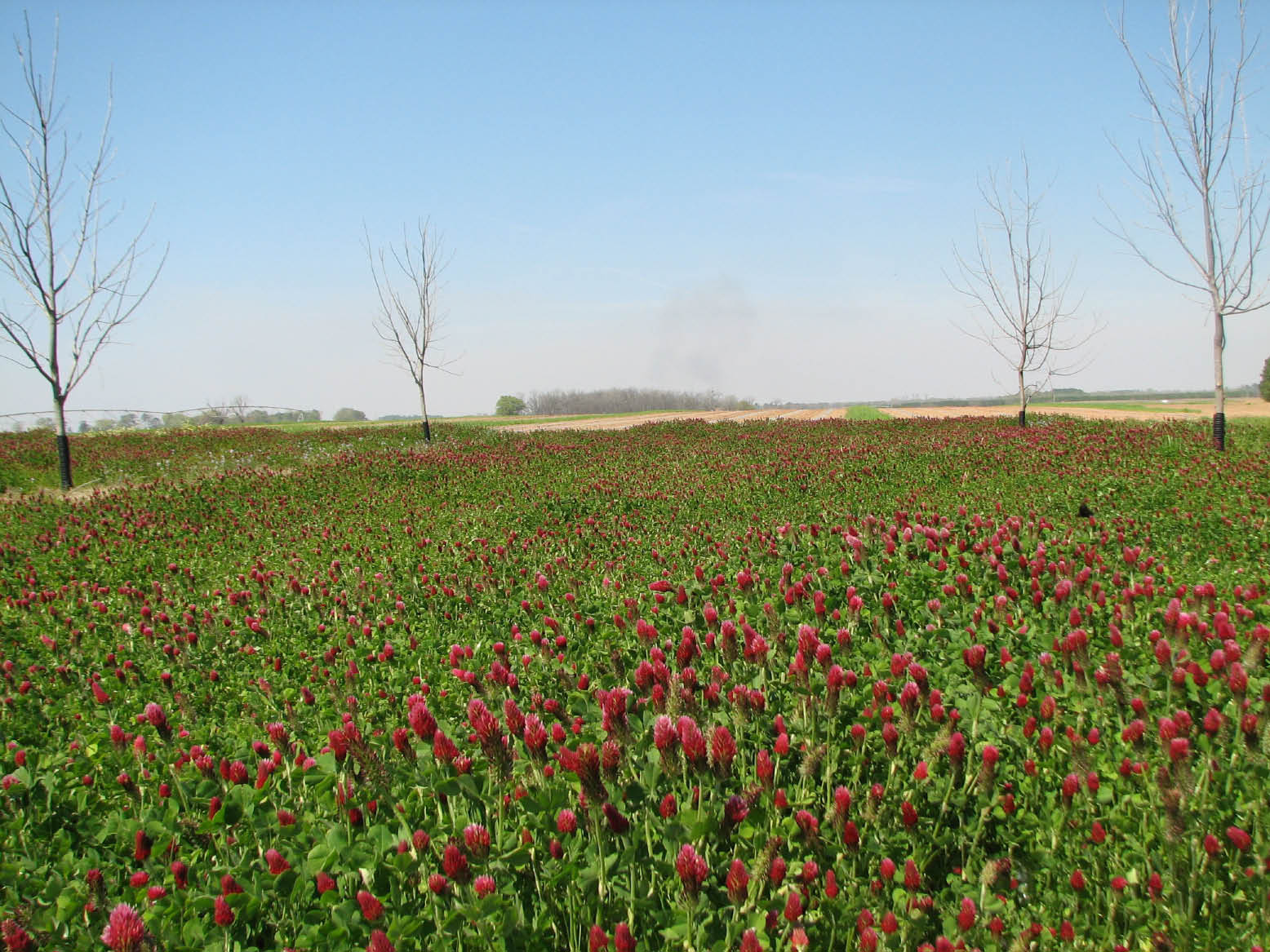 Figure 6. Crimson clover.
Figure 6. Crimson clover.Crimson clover (Figure 6) appears well suited to most pecan orchards. The 'Dixie' variety is one of the most persistent crimson clover varieties throughout much of Georgia's pecan belt. 'Chief', 'AU-Robin', 'Flame' and 'AU Crimson' are also varieties to consider. Crimson clover grows primarily during the cool months of the year, with the growth cycle ending by May or June.
In addition to crimson, ball and white clover, hairy vetch, Augusta vetch, and blue lupine have also been used successfully as cool season legume crops in pecan orchards. One of the most important factors to consider when choosing a legume for the orchard is the soil type and the amount of water available to the legume throughout the year. Full irrigation with solid-set sprinklers allows for a greater selection. Dry-land or drip culture, especially on sandy soils, may limit the choice to those that grow best in winter. Extremely sandy sites may not be suitable for clover or other legumes due to the difficulty of establishment on such soils.
Establishment & Maintenance
In order to establish an adequate stand, Crimson clover should be drilled at 15-18 lb per acre or broadcast at 20-30 lb per acre. White clover should be drilled at 2-3 lb per acre. If white clover seed are broadcast, the seeding rate should be increased by 25%. Take careful steps to plant clover at the appropriate depth (no greater than 1/4 in.). Planting clover seed too deeply commonly results in stand failure. Establishment should be completed as soon as possible following pecan harvest, preferably in November or December. If clover is seeded prior to harvest, seeds may be removed from the orchard floor during the sweeping and harvesting process.
Studies have suggested that white clover over-winters dependably in the southeastern United States and much of the U.S. pecan belt. Crimson clover is a winter annual plant, yet will re-seed itself adequately in the southern pecan producing regions for three to five years before additional planting is required. Sandy sites will need to be re-seeded sooner than loamy or clay soils, so soil type should be taken into consideration when estimating the need for re-establishment.
Since legumes require the presence of rhizobial bacteria to effectively fix N, it is important to obtain the correct rhizobial inoculant for the legume being grown. Fresh inoculant and a sticking agent should be mixed with the seed, otherwise there will be few nodules and N fixation will be low. Soil pH should be maintained at 6.5 because Rhizobia bacteria cannot function properly under highly acidic conditions and will die in soils with pH below 5.0. After establishment, foregoing mowing of the orchard until clover has gone to seed allows producers to take advantage of its re-seeding ability.
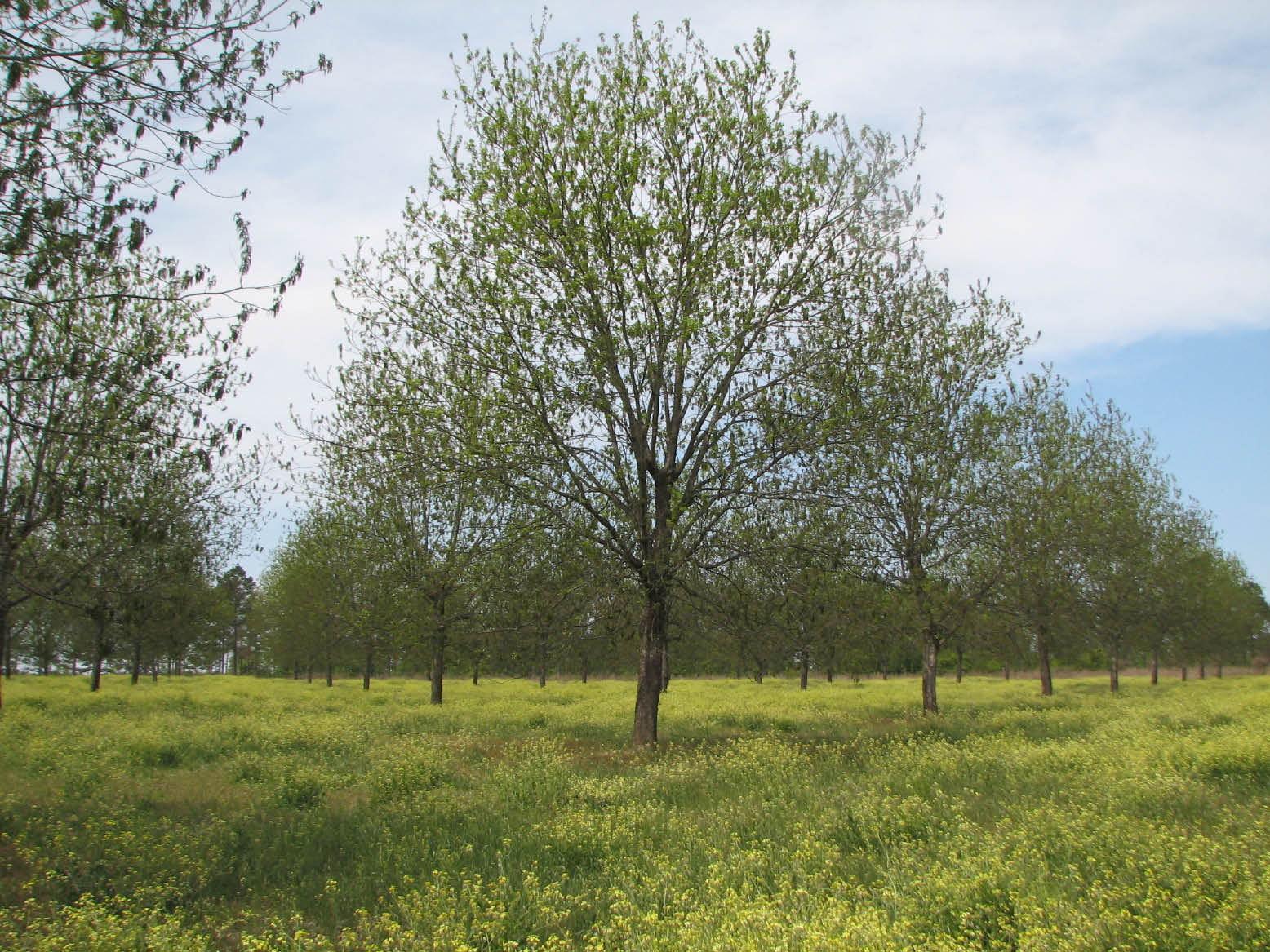 Figure 7. Wild radish growing in a commercial pecan orchard.
Figure 7. Wild radish growing in a commercial pecan orchard.One of the most difficult aspects of managing clover in the orchard is maintaining effective control of competitive weeds. Many southeastern orchards have well-established populations of annual ryegrass. Where this occurs, the ryegrass often competes with and inhibits clover growth. This can be prevented by applying oryzalin herbicide (1 quart per acre) in September or a low rate (1 pint per acre) of sethoxydim herbicide with 1 pint per acre of crop oil in February. The rye grass does not have to be eliminated -- only stunted -- by this application in order to release clover from competition.
Unfortunately, elimination of cool-season rye-grass often releases additional broadleaf weeds, such as wild radish, in the orchard (Figure 7). Effective control of wild radish can be achieved with 1 pint per acre of 2,4-DB applied in mid-January. Although this treatment may burn the clover to some extent, it tolerates the damage and recovers relatively quickly.
 Figure 8. Weed wiper used for broadleaf weed control in orchards utilizing clover as an orchard floor cover.
Figure 8. Weed wiper used for broadleaf weed control in orchards utilizing clover as an orchard floor cover.Photo: Bill Goff, Auburn University.
Another option for grass and broadleaf weed management where clover is grown in the orchard is herbicide application with a weed-wiper (Figure 8). There are a variety of wick or wiper applicators on the market. Best results for orchard use are often attained with models that have a rotating drum covered with a carpet-like material, which absorbs the herbicide solution. The rotating drum catches the weed and wipes herbicide onto the undersurface of the plant as it rotates. The wiper can be set to wipe weeds at a desired height (usually 4 to 8 in.), preventing contact with the clover. An effective tank mix for managing a combination of grass and broadleaf weeds with a weed wiper is 5% glyphosate + 4% 2,4-D amine + 1/2 gallon of detergent per 100 gallons of water. Bear in mind that the use of 2,4-D in pecan orchards may be a hazard under hot conditions.
Clover also uses significant amounts of phosphorous (P), potassium (K) and zinc (Zn), all of which are essential required nutrients for pecans. Therefore growers should closely monitor soil levels of these nutrients and apply as needed, particularly during the first few years of clover establishment.
Costs & Savings
The approximate cost of clover seed and bacterial inoculum required to produce N-fixing nodules is $40 per acre. At N prices of $72 per acre, this represents a difference of $32 per acre. Clover can replace from 50% to 100% of synthetic N applied to pecan orchards, depending on the pecan crop load in a given year. This would save growers approximately $36 to $72 per acre and significantly reduce the grower's reliance on synthetic N. Reduced maintenance and mowing compared to grass covers creates further economic savings and reduces fuel consumption.
Estimating the Nitrogen Benefit of Clover
The following example can be used as a guideline to estimate the N contribution of clover to orchard soil:
At 100% ground cover and 6 in. in height, crimson clover can produce approximately 2,000 lb per acre of dry matter. For every inch over 6 in., an additional 150 lb per acre of dry matter are produced.
So, for 18-in. clover: 2,000 lb + 1,800 lb = 3,800 lb dry matter.
If the clover stand is less than 100%, multiply pounds dry matter produced by percent stand (for example: 60% stand = 3,800 X 0.6 = 2,280 lb).
Legumes typically have 3.5% N at flowering. In pecan orchards, the clover is allowed to re-seed; therefore, some of the N produced by the clover will be utilized to produce its own seed. So, after flowering, legumes may have only 2% to 3% N.
Therefore, a 60% stand of crimson clover can provide about 68.4 pounds N per acre (2,280 pounds X 0.03 = 68.4 pounds N per acre).
Summary
One of farming's greatest challenges is keeping N in a stable, storable form until the crop needs it. The use of organic N, such as that produced by legumes, is an ideal way to accomplish this. Combining warm season sod culture and cool season legumes is a practical and effective strategy for conserving and supplying nitrogen for orchard crops, as well as enhancing stewardship of the environment through the enhancement of beneficial insects, weed suppression, and soil sustainability.
References
Cedarbaum, S. B., Carroll, J. P., & Cooper, R. J. (2004). Effects of alternative cotton agriculture on avian and arthropod populations. Conservation Biology, 18, 1272–1282. https://doi.org/10.1111/j.1523-1739.2004.00385.x
Clark, A. (Ed.). (2012). Managing Cover Crops Profitably. Sustainable Agriculture Research and Education Program. https://www.sare.org/wp-content/uploads/Managing-Cover-Crops-Profitably.pdf
Hancock, D., & Harmon, D. (2016). White clover establishment and management guide (Publication No. B 1251). University of Georgia Cooperative Extension. https://extension.uga.edu/publications/detail.html?number=B1251
McGraw, D., & Smith, M. (1996). Use of legumes in pecan orchards (Fact Sheet F-6250). Oklahoma Cooperative Extension.
Smith, M. W., Shiferaw, A., & Rice, N. R. (1996). Legume cover crops as a nitrogen source for pecan. J. Plant Nutrition, 19, 1117–1130. https://doi.org/10.1080/01904169609365184
Weinbaum, S. A., Johnson, R. S., & Dejong, T. M. (1992). Causes and consequences of overfertilization in orchards. Hort Technology, 2, 112–121. https://doi.org/10.21273/HORTTECH.2.1.112b
Wells, M. L. (2009). Pecan nutrient element status and orchard soil fertility in the southeastern coastal plain of the United States. Hort Technology, 19, 432–438. https://doi.org/10.21273/HORTTECH.19.2.432
White, A. W., Beatty, E. R., & Tedders, W. L. (1981). Legumes as a source of nitrogen and effects of management practices on legumes in pecan orchards. Proc. Southeastern Pecan Growers Assoc., 74, 97–106.
Status and Revision History
Published on Dec 11, 2009
Published with Full Review on Apr 26, 2013
Published with Full Review on Mar 28, 2017
Published with Full Review on Oct 09, 2024


























































